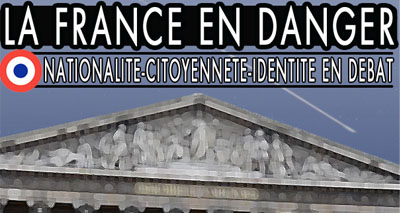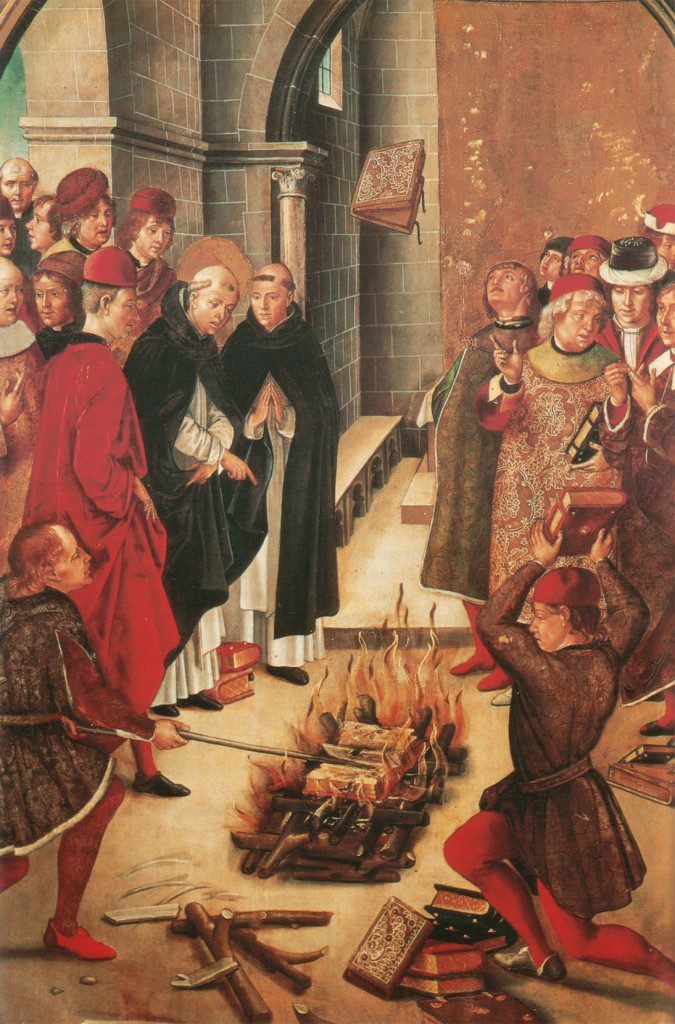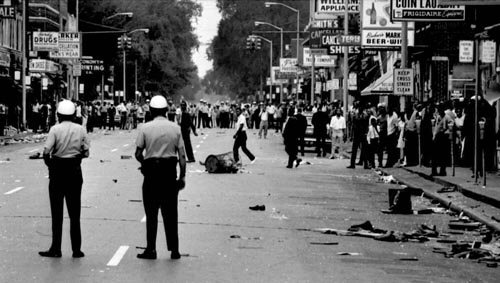Jared Taylor to Address French Nationalists in Paris
Henry Wolff, American Renaissance, March 9, 2012

On Saturday, March 10, Jared Taylor will be speaking at a conference in Paris called “France in Danger.” It is sponsored by a group called Nationality-Citizenship-Identity (NCI), which expects an audience of approximately 1,000. Here is some of the advance publicity given by NCI to appearances by Mr. Taylor and by Filip Dewinter of the Vlaams Belang.
NCI has three primary objectives, which are outlined on its website as follows:
- To oppose the granting of the right to vote to all foreigners who are not citizens of a country that is part of the European Union.
- To inform our fellow citizens who want to return to the true meaning of “French nationality,” and to give them an opportunity to meet each other.
- To propose a complete recasting of the law of French citizenship so as to adapt it to our evolving world.
Mr. Taylor will speak in French, but what follows is an English-language summary of his remarks.
The American Cult of Diversity
By Jared Taylor
It is now obligatory for every politician, journalist, and academic in America to praise diversity — diversity of religion, language, culture, and race. The most common way to do this is to say, “Diversity is our strength,” or even to say, “Diversity is America’s greatest strength.”
Not surprisingly, President Obama says this frequently, but in 2007 even General George Casey, who was in command of all American troops in Iraq, announced, “I firmly believe the strength of our Army comes from our diversity.”
The cult of diversity is now so deeply implanted in American public discourse, that to point out the disadvantages of diversity is almost like attacking the Church in the Middle Ages. In America we do not have laws like the Loi Gayssot or the Loi Pleve [that criminalize certain kinds of speech], but to criticize diversity — or any of the groups or cultures that make America more diverse — can be career suicide.
If diversity is a wonderful thing, Americans would seek it voluntarily. They do not. Whatever they may say about it publicly, they do not want diversity in their personal lives.
For many years it was common to establish racially exclusive residential neighborhoods, but that practice was declared illegal in 1948. However, Americans now voluntarily segregate. A recent study by the Lewis Mumford Center for Comparative Urban and Regional Research, for example, has found that in New York and Chicago, black/white housing patterns have not changed since the 1920s. Brian Stults of the University of Florida has found that blacks with high incomes move into up-scale black neighborhoods rather than into white neighborhoods. He found that rising black income has “no effect” on housing integration.
The same is true of church attendance. Ninety-five percent of American church congregations are at least 80 percent one race or ethnic group. In many congregations the figure is 100 percent.
Schools in the United States were legally segregated until 1954, and from the 1960s through the 1990s, there was a long and painful effort to integrate schools by requiring students to attend particular schools for the express purpose of ethnic mixing. At the time, according to what was called “contact theory,” children of different races would learn to appreciate each other if they met at an early age.
This was a failure. White students left the public schools by the millions. Many attended private schools, and many moved with their families to areas where there were few minorities. The attempt to integrate schools by force therefore increased residential segregation. Today, in America’s large cities, many public schools are now almost exclusively black and Hispanic. For the school year 2006-2007, the white percentage was the following in these major urban districts: Atlanta — 9.0 percent; Los Angeles — 8.8 percent; Miami — 8.5; Houston, Texas — 8.3 percent; Baltimore — 7.7 percent; Chicago — 7.3 percent; Washington, DC — 5.7 percent; Dallas — 5.0 percent; San Antonio, Texas — 3.0 percent; Detroit — 2.4 percent.
Whites who are able to escape school “diversity” have done so.
Most blacks and Hispanics cannot afford to attend private schools, and they do not find that the “diversity” in their schools is a strength. Southern California schools, especially, have large numbers of black and Hispanic students, and highs schools are often shut down because of race riots. In some schools, police constantly patrol the hallways. Students enter schools through metal detectors to make sure they are not carrying weapons. They take “diversity” courses to encourage blacks and Hispanics to appreciate each other, and attend sessions in “conflict resolution” that are supposed to lead to peaceful solutions. Schools have posters on walls that say “Black and Brown = Peace.” None of this solves the problem.
In Michigan, where there are many Arab students, so there is fighting between blacks and Arabs. In Texas, there is fighting between Hispanics and American Indians. In Minnesota, where there are many Somali refugees, there is even fighting between Somali students and American blacks. “Diversity” is not a source of strength in American schools.
In prisons, the consequences are even worse. Federal law forbids segregation of prisoners by race, so there are serious prison race riots. In 2006 there was a four-hour black/Hispanic riot in a Los Angeles prison, in which one man was killed and 20 inmates were so badly injured they had to be hospitalized. Los Angeles County Sheriff Lee Baca broke the law and temporarily segregated the prisoners. “Human life is more important than appearance,” he explained. One Hispanic prisoner was quoted as asking, “Please separate us race by race for everyone’s safety.”
For ten years, Asian prisoners in Los Angeles jails were kept in segregated dormitories because Mexican prisoners had a policy of attacking them on sight. When the segregation policy was ended in 2004, Asian prisoners set fire to their cells in protest. “It’s like feeding us to the sharks,” said one.
The state of California continued to practice limited segregation of prisoners until 2005, when the Supreme Court banned this practice. The state very slowly integrated prisons, but inmates protested by refusing to eat or leave their cells. “This is like using us like lab rats, to see if it works,” said black inmate Glenn Brooks. “All it’s going to do is get somebody hurt, get somebody killed.”
In August 2009 at the state prison in Chino, about 40 miles east of Los Angeles, attempts at integration led to an 11-hour black/Hispanic riot in which 250 men were injured and 55 had to be hospitalized. Inmates burned down six of the eight 200-man dormitories. Prisoners were resegregated after the riot.
In 2009, a black/white race riot at a prison near Danville, Kentucky resulted in fires that destroyed six buildings and left 700 prisoners without housing.
Everyone who is involved with prisons — guards, prisoners, prison managers — want segregation, but because the official policy of the United States is that diversity is a strength, prisoners must mix by race, and face violence and possible murder.
In Southern California there are neighborhoods where blacks and Hispanics systematically attack and kill each other. In June 2008, Sheriff Lee Baca wrote this in the Los Angeles Times:
We have a serious interracial violence problem in this county involving blacks and
Latinos … Latino gang members shoot blacks not because they’re members of a rival gang but because of their skin color … Some of L.A.’s [Los Angeles’s] so-called gangs are really no more than loose-knit bands of blacks or Latinos roaming the streets looking for people of the other color to shoot.
In May 2009, federal officials charged 147 members of a Hispanic gang based in the Southern California city of Hawaiian Gardens with driving blacks out of the city through violence. US Prosecuting Attorney Thomas P. O’Brien called this “the largest gang takedown in United States history,” but the case received very little public attention. The media do not like to report news that contradicts the official view that diversity is a strength.
The United States has tried very hard to produce equality for all groups in America through discrimination in favor of blacks and Hispanics, equal spending on schools, food stamps, and free housing for the poor. Still, the profiles of different groups are radically different.
For example, in 2008, the illegitimacy rates in the United States were as follows:
| White | Black | Hispanic | American Indian | Asian |
|---|---|---|---|---|
| 29% | 72% | 53% | 66% | 17% |
In many European countries, illegitimacy rates are high — the figure was 50 percent for France in 2007 — but many European children are born to stable couples. In the United States, most illegitimate children are born to single mothers, and live in very difficult circumstances.
Academic performance varies greatly by group. By the fourth grade, the average black or Hispanic student is performing at a level two years behind the average white or Asian student. By the 12th grade — the end of the high school — the average black or Hispanic is the equivalent of four years behind the average white or Asian. This is the same all across the United States, whether in integrated or heavily segregated schools.
Blacks are seven times more likely than whites to be in prison and Hispanics are twice as likely. This is not because of discrimination in the justice system. Every year, the Department of Justice conducts the National Crime Victimization Survey, in which victims of crime are asked the race of the person who robbed or attacked them. It is clear that police arrest blacks and Hispanics only because they commit more crimes. Asians are only one third as likely to be in American prisons because they are the group least likely to commit crimes.
There are group differences in disease rates. The United States Centers for Disease Control (CDC) reported that in 2006, black men were six times more likely than white men to have HIV/AIDS, and Hispanics were 2.2 times more likely. Black women were 18 times more likely than white women to be infected, and Hispanic women were 4.2 times more likely. The CDC also finds that blacks have gonorrhea rates 19 times higher and syphilis rates that are seven times higher than non-blacks.
Because different groups have different social profiles, and because of residential segregation, different parts of the United States can be so different that they almost seem to be different countries. Hispanics buy very few books, so there is not a single book store in the entire city of heavily Hispanic Miami. El Cenizo is a Texas town with so many Hispanic residents that city business is conducted exclusively in Spanish. Oakland, California, used to have a world-class symphony orchestra but the city became heavily black, and the orchestra was disbanded.
The city of Detroit used to be an industrial center — it was the headquarters of the automobile industry — but whites fled the city after race riots. It is now 82 percent black, and is bankrupt. Many downtown skyscrapers are empty and abandoned. Large parts of the city have been abandoned, and no longer offer electricity, gas service, or mail delivery.
Camden, New Jersey, was also a great industrial city until the 1950s. In 1971 there were race riots and whites fled. It sank into chaos, mismanagement, and corruption. Three mayors — all black — went to jail. In 2002 the state took over management of the city, but this has done little good. It still has the highest rates of homelessness, unemployment, and school dropout in America. Every year, it is ranked as either the most violent or the second-most violent city in America. Churches hire police guards to prevent armed robbers from stealing the offering during worship services. Camden can no longer afford its own police force and is the only city in the state that has officially asked the surrounding county to provide police service.
Diversity is not a strength for any country. Tatu Vanhanen of the University of Tampere, Finland, has studied the effects of cultural, ethnic, and religious diversity in 148 countries. He has found that diversity has a positive correlation in the 0.5 to 0.9 range with internal conflict and violence. This is why homogeneous countries like Japan and Iceland show very low levels of conflict, while highly diverse countries like Lebanon and Sudan are wracked with strife.
France is already on its way to becoming a “diverse” country like the United States. Also, because of its laws against free speech, it is also becoming very difficult to speak and write truthfully about the costs of diversity.
I am an American, but I have lived in France, studied in France, and have a deep affection and respect for France and its people. It is absolutely essential that France — for its own sake and for the sake of the world — remain French. It France becomes “diverse” it will cease to be French. Vive la France!

















